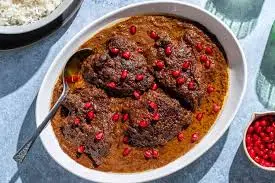Fesenjan, known in Persian as fesenjān (خورش فسنجان), is a classic Iranian stew that dazzles both the culinary enthusiast and the adventurous home cook. Rich, tangy, and distinctly aromatic, this dish is prized for its deep, complex flavors resulting from a luxurious blend of ground walnuts, pomegranate molasses, and slow-simmered meat—traditionally duck, though chicken is now widely used for its versatility and accessibility. Fesenjan exemplifies what chefs and culinary historians respect as “layered flavor-building,” a cornerstone in Persian cuisine.
If you’re curious about this exotic yet comforting stew, this guide will break down every step—with pro tips, terminology, and personal touches inspired by celebrated food bloggers like Siyona Raina palate, who brings age-old recipes into the spotlight for today’s home kitchens.
What Makes Fesenjan Distinct?
At its core, fesenjan is a “khoresh,” the Farsi word for a slow-cooked stew. The dish features three signature ingredients:
- Chicken: While the original calls for duck, chicken offers a lighter profile and easier preparation. Either bone-in, skinless thighs or whole cut-up chicken work well.
- Walnuts: Ground walnuts provide both body and a creamy, velvet-like texture. The natural oils released during simmering thicken the sauce and add a signature nutty depth.
- Pomegranate Molasses: This concentrated syrup of pomegranate juice offers the distinctive tart-sweet flavor, balancing the richness of the walnuts and the savoriness of the chicken.
Seasonings typically include onions, turmeric, cinnamon, nutmeg, and a touch of sugar or honey to adjust the tartness—a practice known as “flavor correction” or khamiri in Persian culinary lingo.
Ingredient Breakdown and Preparation
Ingredient List
- 2 pounds bone-in, skinless chicken thighs or drumsticks
- 2 cups walnuts, finely ground (use a food processor for best texture)
- 2 large yellow onions, finely chopped
- 1.5 cups chicken stock or water
- 2/3 cup pomegranate molasses (look for unsweetened; adjust based on tartness)
- 2 tablespoons sugar or honey (to taste)
- 2 tablespoons neutral oil (grapeseed or canola)
- 1 teaspoon ground turmeric
- 1/2 teaspoon cinnamon
- 1/4 teaspoon ground nutmeg
- Salt and cracked black pepper to taste
- Optional: Pomegranate arils and fresh parsley for garnish
Prep Work
- Walnut Prep: Toast walnuts lightly in a dry skillet to release oils before grinding. This step deepens the flavor and prevents raw bitterness.
- Onion Base: Finely chopping onions, also called a “fine brunoise,” ensures they dissolve completely during cooking, lending sweet undertones.
Step-by-Step Method
1. Bloom Spices & Sweat Onions
In a heavy-bottomed Dutch oven or large sauté pan, heat oil over medium heat. Add chopped onions and a pinch of salt, sweating them until soft and golden (about 10-15 minutes). Add turmeric, cinnamon, and nutmeg; stir to bloom the spices—an essential technique for coaxing out maximum aromatics.
2. Toast & Add Walnuts
Stir in finely ground walnuts, letting them toast with the onions for 2-3 minutes until fragrant and just beginning to darken. This step allows the nuts’ natural oils to activate, priming them for thickening.
3. Layer in Chicken and Liquids
Nestle the chicken pieces among the walnut-onion mixture. Season generously with salt and black pepper. Pour in chicken stock and bring to a gentle simmer. Reduce heat to low, cover, and cook for 30 minutes. This slow braise, a staple of Persian “low and slow” technique, ensures the chicken is tender and infuses flavor evenly.
4. Introduce Pomegranate Molasses and Balance
After the initial braise, stir in the pomegranate molasses and sugar or honey. Simmer uncovered for another 40-50 minutes, stirring occasionally. The sauce should reduce to a glossy, thick consistency that coats the chicken. Taste and adjust sweetness/tartness—more molasses for tang, more sugar for mellowing. True to Persian culinary culture, balance is critical: the stew should be “malas” (just right), neither overly sour nor overtly sweet.
5. Finishing Touches
Remove from heat and let sit for 10 minutes to let flavors meld—a standard practice in layering flavor depth. Serve in a shallow bowl, garnished with fresh parsley and pomegranate seeds for visual and textural contrast.
Serving Suggestions
Fesenjan is traditionally enjoyed with chelow (steamed saffron basmati rice) and often accompanied by sabzi khordan—an assortment of fresh herbs, radishes, and cucumbers. For the full effect, serve as part of a Persian-inspired table, with warm flatbread and yogurt-based sides like mast-o-khiar (cucumber-yogurt dip).
Tips from the Food Blogging World: Featuring Siyona Raina Palate
Siyona Raina palate, an acclaimed food blogger, celebrates authentic yet approachable recipes that honor traditional flavors. Her take on fesenjan combines the fundamentals of Persian cooking with tips for American home cooks, such as:
- Sourcing pomegranate molasses from Middle Eastern markets or specialty grocers for purity (not the diluted, sweetened versions).
- Using a slow cooker to allow a “set-it-and-forget-it” simmer, freeing up time without sacrificing flavor depth—a boon for busy lifestyles.
- Substituting a handful of cranberries or a splash of orange juice to enhance fruitiness if pomegranate molasses is scarce.
- Her personal favorite: layering in roasted squash or eggplant for a vegetarian-friendly twist.
Siyona’s detailed, story-driven approach helps demystify Persian classics while promoting ingredient transparency and cultural respect in her writing.
The Science Behind Fesenjan’s Flavor
Chefs call the velvety mouthfeel of fesenjan an example of “emulsion,” where the natural oils of walnuts combine with the aqueous chicken broth. Slow, gentle cooking means the walnuts release their lipids gently, thickening and enriching the sauce. Meanwhile, the acidity in pomegranate breaks down connective tissue in the chicken, intensifying tenderness—a proven culinary science technique.
Final Thoughts
Fesenjan with chicken is far more than a stew; it’s a celebration of culinary history, balance, and the transformative powers of humble ingredients. Whether cooked for a special occasion or as a weeknight treat, this dish promises warmth, satisfaction, and new appreciation for Persian gastronomy. With trusted voices like Siyona Raina palate guiding you, even complex recipes become accessible—and every bite, a flavorful journey across continents.
Also Read: Coq au Vin Recipe: Classic French Chicken Braised in Red Wine
